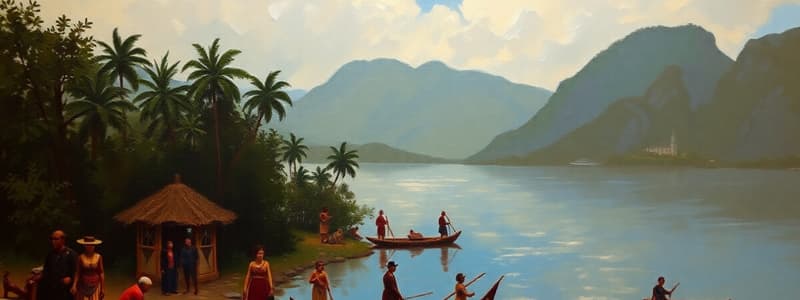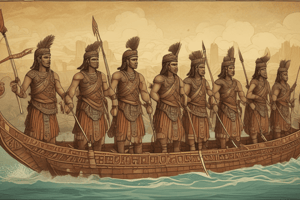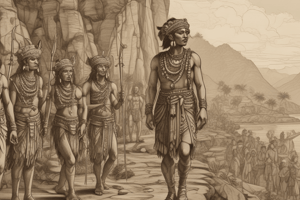Podcast
Questions and Answers
What was one of the main reasons for the failure of the encomienda system?
What was one of the main reasons for the failure of the encomienda system?
Who was Bartholomew de las Casas?
Who was Bartholomew de las Casas?
What system replaced the encomienda after its abolition?
What system replaced the encomienda after its abolition?
What was a major characteristic of the debt peonage system?
What was a major characteristic of the debt peonage system?
Signup and view all the answers
What was a significant outcome of the era of European exploration?
What was a significant outcome of the era of European exploration?
Signup and view all the answers
Which of the following motivated European explorers during their expeditions?
Which of the following motivated European explorers during their expeditions?
Signup and view all the answers
What impact did the introduction of tea have on Europe during this time?
What impact did the introduction of tea have on Europe during this time?
Signup and view all the answers
What advantage did the repartimiento system offer to Amerindians?
What advantage did the repartimiento system offer to Amerindians?
Signup and view all the answers
Which group came directly after poor whites in the social pyramid?
Which group came directly after poor whites in the social pyramid?
Signup and view all the answers
What was a common characteristic of the coloured elite in the plantation society?
What was a common characteristic of the coloured elite in the plantation society?
Signup and view all the answers
Which group had the most opportunities for social mobility?
Which group had the most opportunities for social mobility?
Signup and view all the answers
What was the primary purpose of the plantation system during the 15th-17th centuries?
What was the primary purpose of the plantation system during the 15th-17th centuries?
Signup and view all the answers
What role did skin color play in the plantation society?
What role did skin color play in the plantation society?
Signup and view all the answers
Which statement best describes the plantation hierarchy?
Which statement best describes the plantation hierarchy?
Signup and view all the answers
What was one of the key motivations behind the plantation model?
What was one of the key motivations behind the plantation model?
Signup and view all the answers
Which type of slaves were primarily responsible for cultivating the sugar crop?
Which type of slaves were primarily responsible for cultivating the sugar crop?
Signup and view all the answers
What is one factor that contributed to the Haitian Revolution?
What is one factor that contributed to the Haitian Revolution?
Signup and view all the answers
Which method of non-violent resistance involved slaves pretending to be ill?
Which method of non-violent resistance involved slaves pretending to be ill?
Signup and view all the answers
What event did slaves in Barbados mistakenly believe led to their emancipation?
What event did slaves in Barbados mistakenly believe led to their emancipation?
Signup and view all the answers
What leadership was pivotal during the Haitian Revolution?
What leadership was pivotal during the Haitian Revolution?
Signup and view all the answers
During the Demerara Uprising, who were key figures in leading the rebellion?
During the Demerara Uprising, who were key figures in leading the rebellion?
Signup and view all the answers
What was a significant outcome of the Barbados Rebellion in 1816?
What was a significant outcome of the Barbados Rebellion in 1816?
Signup and view all the answers
How did maroonage contribute to the domestic economy?
How did maroonage contribute to the domestic economy?
Signup and view all the answers
What characterized the Barbados Rebellion of 1816?
What characterized the Barbados Rebellion of 1816?
Signup and view all the answers
What was one of the main reasons for the revolt among Christian slaves?
What was one of the main reasons for the revolt among Christian slaves?
Signup and view all the answers
Who was responsible for betraying the rebellion and informing on the slaves?
Who was responsible for betraying the rebellion and informing on the slaves?
Signup and view all the answers
What was the outcome of Rev. John Smith's actions during the revolt?
What was the outcome of Rev. John Smith's actions during the revolt?
Signup and view all the answers
Which factor contributed to the quick collapse of the uprising, despite the slaves being heavily armed?
Which factor contributed to the quick collapse of the uprising, despite the slaves being heavily armed?
Signup and view all the answers
What significant action did Sam Sharpe lead during the rebellion?
What significant action did Sam Sharpe lead during the rebellion?
Signup and view all the answers
What was one of the consequences of the Muharram Massacre of 1884?
What was one of the consequences of the Muharram Massacre of 1884?
Signup and view all the answers
How did the uprising led by Sam Sharpe impact property in Jamaica?
How did the uprising led by Sam Sharpe impact property in Jamaica?
Signup and view all the answers
What ignited the Muharram Massacre in 1884?
What ignited the Muharram Massacre in 1884?
Signup and view all the answers
What was a significant reason for the Free Village Movement's emergence?
What was a significant reason for the Free Village Movement's emergence?
Signup and view all the answers
What impact did the peasantry have on agricultural practices after the end of slavery?
What impact did the peasantry have on agricultural practices after the end of slavery?
Signup and view all the answers
Which of the following best describes the attitude of the planters towards the Free Village Movement?
Which of the following best describes the attitude of the planters towards the Free Village Movement?
Signup and view all the answers
What was one of the immediate results of the Morant Bay Rebellion?
What was one of the immediate results of the Morant Bay Rebellion?
Signup and view all the answers
How did the attitudes of colonial governors impact the Free Village Movement?
How did the attitudes of colonial governors impact the Free Village Movement?
Signup and view all the answers
What social outcome resulted from increased interaction among different races post-emancipation?
What social outcome resulted from increased interaction among different races post-emancipation?
Signup and view all the answers
Why did few Indians understand the reading of the Riot Act during the event in San Fernando?
Why did few Indians understand the reading of the Riot Act during the event in San Fernando?
Signup and view all the answers
What was one main reason for resistance against the Free Village Movement by the colonial government?
What was one main reason for resistance against the Free Village Movement by the colonial government?
Signup and view all the answers
What was one primary reason for the failure of the West Indian Federation?
What was one primary reason for the failure of the West Indian Federation?
Signup and view all the answers
How did the Atlantic Charter of Human Rights influence the Caribbean independence movement?
How did the Atlantic Charter of Human Rights influence the Caribbean independence movement?
Signup and view all the answers
Political enfranchisement significantly impacted which aspect of independence?
Political enfranchisement significantly impacted which aspect of independence?
Signup and view all the answers
What is a consequence of economic enfranchisement following independence?
What is a consequence of economic enfranchisement following independence?
Signup and view all the answers
What role did the collapse of the West Indian Federation play in achieving independence?
What role did the collapse of the West Indian Federation play in achieving independence?
Signup and view all the answers
What impact did adult suffrage have on the political landscape in the Caribbean?
What impact did adult suffrage have on the political landscape in the Caribbean?
Signup and view all the answers
What was a key factor for native people's ability to dictate economic processes post-independence?
What was a key factor for native people's ability to dictate economic processes post-independence?
Signup and view all the answers
Which factor illustrates the relationship between political and economic enfranchisement in the Caribbean?
Which factor illustrates the relationship between political and economic enfranchisement in the Caribbean?
Signup and view all the answers
Study Notes
Migratory Movements Within the Region From Pre-Columbian Times to 1838
- Ancestors of pre-Columbian Amerindians likely migrated from Northeast Asia to Alaska across the Bering Strait (40,000-12,000 BCE)
- These people were nomadic, traveling through the Americas
- Distinct physical and cultural characteristics developed
- Main indigenous groups in 1492, included the Lucayans, Tainos, Ignerian Arawaks, Kalinagos, Aztecs, Maya, Toltec, Itza, and Inca
Social Structures
- Tainos had larger settlements and greater involvement in decisions compared to smaller Kalinagos groups with less involvement
- Tainos were more agrarian; Kalinagos were hunter-gatherers
Economic Systems
- Tainos practiced more agrarian techniques
- Kalinagos were less skilled at agriculture, relying on slash-and-burn methods
Political Systems
- Tainos had hereditary leadership (Cacique)
- Kalinagos had a warrior chosen to lead
Military Systems
- Tainos and Kalinagos had varying levels of warfare.
- Tainos less war-like, and Kalinagos more aggressive
Religious Beliefs
- Both groups had naturalistic/spiritual beliefs.
Pre-Columbian Cultures
- Ciboney (early inhabitants of the Greater Antilles), whose disappearance occurred before the Spanish arrival.
- Tainos (arrived around 300 BCE); known for their farming style, conuco
- Kalinagos (last group to arrive) skilled in hunting and gathering, this helped them survive.
Christopher Columbus and the Columbian Exchange
- Columbus' arrival in 1492 triggered mass migration of Europeans, Africans and Asians to the Caribbean
- Spain claimed ownership of the islands for mineral resources.
- This led to the exploitation and enslavement of the indigenous population
- Unsettlement and neglect of areas occurred initially, but the European presence led to permanent settlement.
Impacts of the Spanish Conquests
- Indigenous populations faced extermination through genocide
- European diseases, like smallpox, influenza, syphilis, and harsh treatment
Slash and Burn Agriculture
- The Taino practiced slash-and-burn agriculture, creating conuco farming, for improved soil nutrition and fertility.
- The system allowed intercropping, aiding in soil replenishment
- This was practiced across the world
- This was a less intensive approach that focused on subsistence farming rather than large-scale production
Encomienda System
- A system of land and labour distribution
- Settlemernts were given parcels of land and indigenous people to work on it
- The Amerindians were exploited, not slaves but forced to work.
- This system contributed to the exploitation of the indigenous peoples
Debt Peonage
- Debt peonage is a system of economic enslavement
- Indigenous people accumulated debt that bound them to the system until it was repaid
- This is a system that was implemented after the removal of the encomienda system
The Plantation System
- Sugar production spurred the development of the plantation system in the Carribean
- Europe demanded large amounts of sugar
- The Caribbean's climate and fertile soil were perfect for sugar cane cultivation
- This led to the development of large-scale plantations and the forced use of African slaves as labour
- Indigenous populations were reduced by disease and enslavement
Plantation Societies
- Plantation Societies in the Caribbean were rigidly stratified pyramidal structures.
- The Planter was at the top of the pyramid followed by the Overseers and skilled white staff, Poor Whites, Free Coloureds/Mulattoes, Domestic Slaves/Factory Slaves, and Field Slaves.
Resistance to Colonial Oppression
- Various forms of resistance existed throughout the colonial period including rebellions, legal actions, and the development of organized political movements
The Plantation System's Operations
- Sugar, coffee, tobacco, and cocoa production created a high demand on the European market
- Colonial governments sought to export commodities and consolidate their power through trade
Methods to Stir Up Public Opinion
- Use of slogans, sermons, paintings, petitions, and debates.
Economic Impact of the Decline in Plantation Profitability:
- Plantation profits declined due to competition from other sugar producing areas, such as North America and Europe
- The cost of maintaining slaves was greater than paying wage laborers; this was a crucial factor in the decline of profitability
- The demand for sugar decreased due to increased production in other areas
The Act of Emancipation 1834
- Declared the freedom of all slaves in the British colonies
- Provided for a gradual transition, with an apprenticeship period, before full freedom was granted
Indentureship
- Indentured labour supplied labour in place of slavery
- Main groups who were recruited were Syrian, Lebanese, Free Whites, Chinese and Indians, recruited from Africa and Asia
Causes of Migration
- Economic hardship, political persecution and the collapse of the West Indian Federation increased migration from India to the region
Plantation Resistance
- Forms of resistance included desertion, feigning illness, and destruction of property and equipment.
Violent Resistance:
- Rebellions and revolts, such as the Maroonage, occurred to resist colonial powers
The Haitian Revolution
- The Haitian Revolution, influenced by the French Revolution, resulted in the abolition of slavery in Haiti
- The revolution created social unrest and inspired other uprisings in the Caribbean region
The Barbados Rebellion
- The Barbados Rebellion was a significant revolt that aimed for freedom and opposed harsh treatment within the system.
Demerara Uprising
- A slave uprising that challenged slave masters
Muharram Massacre/ Hosay Massacre
- Mass killings of indentured labourers during a religious procession, highlighting the resistance of the oppressed community
Free Village Movement
- Free Village Movement allowed former slaves to settle on lands outside plantations, creating a new means of economic independence
- Communities of former enslaved people emerged, offering an alternative to plantation life
Colonial Oppression Timeline
- Timeline showing resistance to colonial oppression, involving various groups across the Caribbean.
Movement Towards Independence
- The collapse of the West Indian Federation and the rise of trade unionism and political parties played a role in the movement towards independence.
Atlantic Charter of Human Rights
- Acknowledged the rights of native sovereignty through global recognition and political pressure, during the post World War 2 colonialism era
Economic Enfranchisement
- The ability of the people to determine their mode of production
Entrepreneurial Activities
- The blossoming of entrepreneurial activity following the abolition of slavery
Studying That Suits You
Use AI to generate personalized quizzes and flashcards to suit your learning preferences.
Related Documents
Description
Explore the migratory movements and social, economic, and political systems of the pre-Columbian Amerindians from Northeast Asia to the Americas. This quiz covers the distinct characteristics of major indigenous groups such as the Tainos and Kalinagos. Test your knowledge of their cultural practices and societal structures leading up to 1838.




